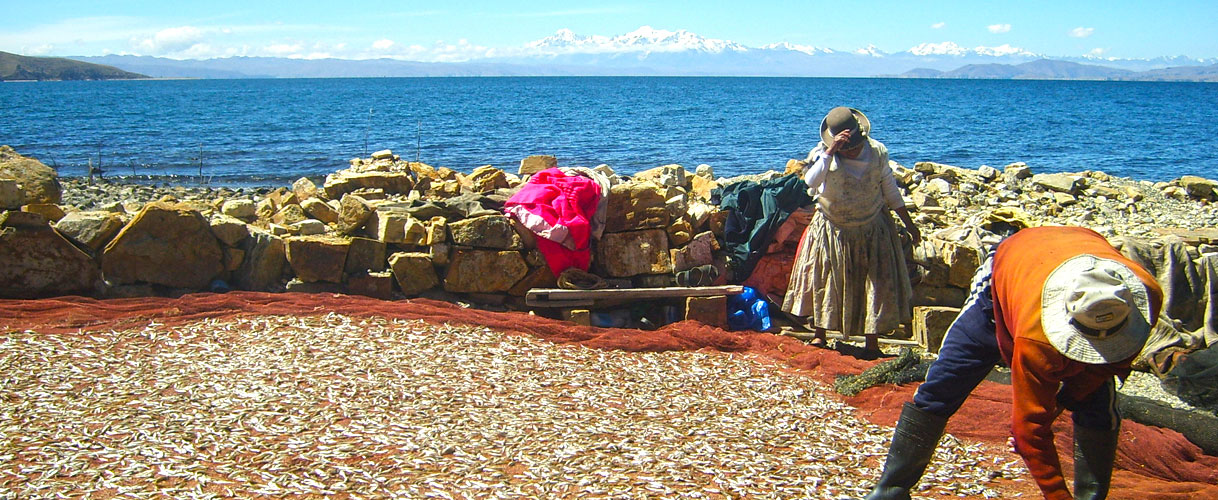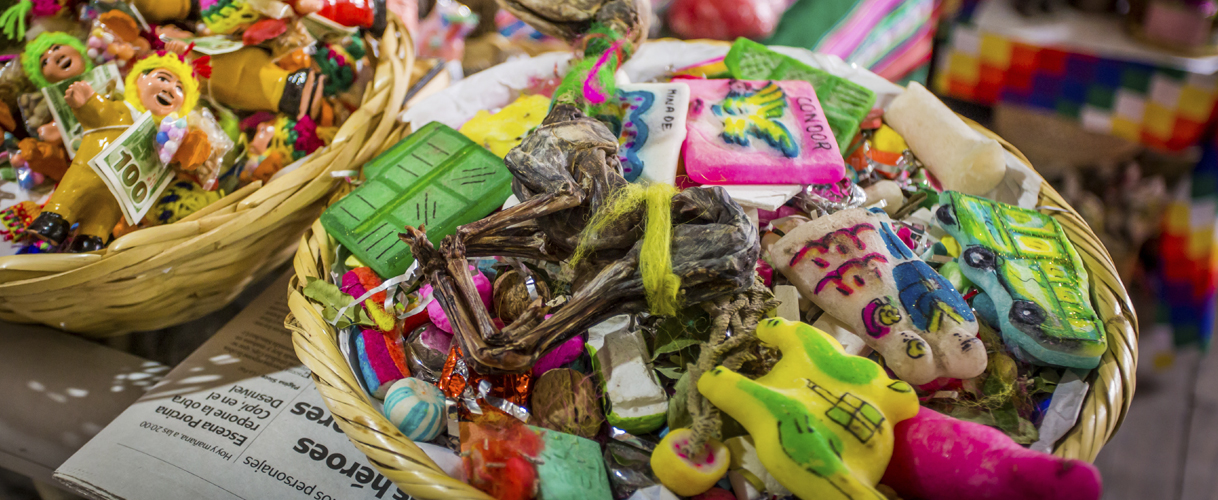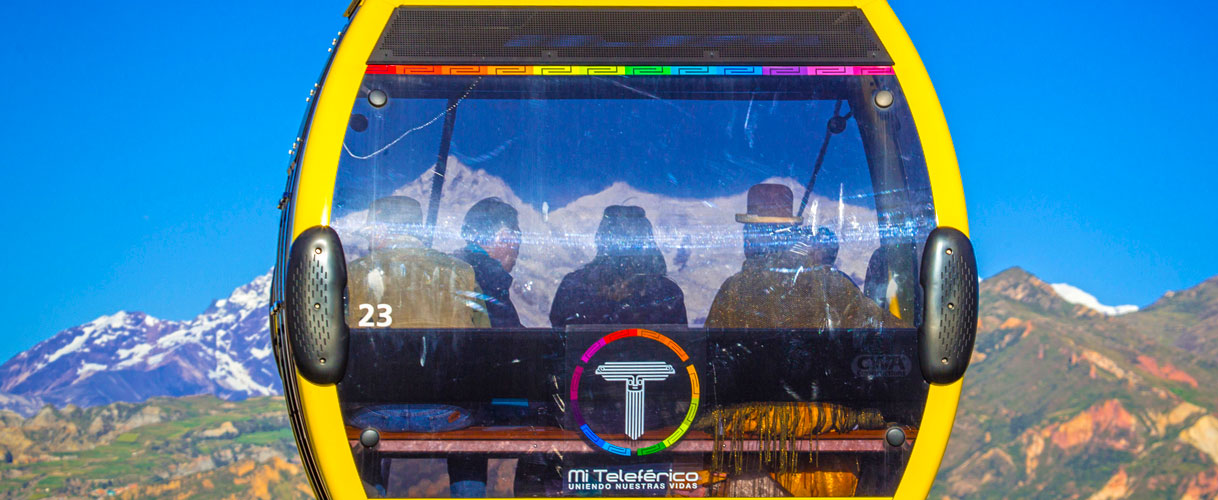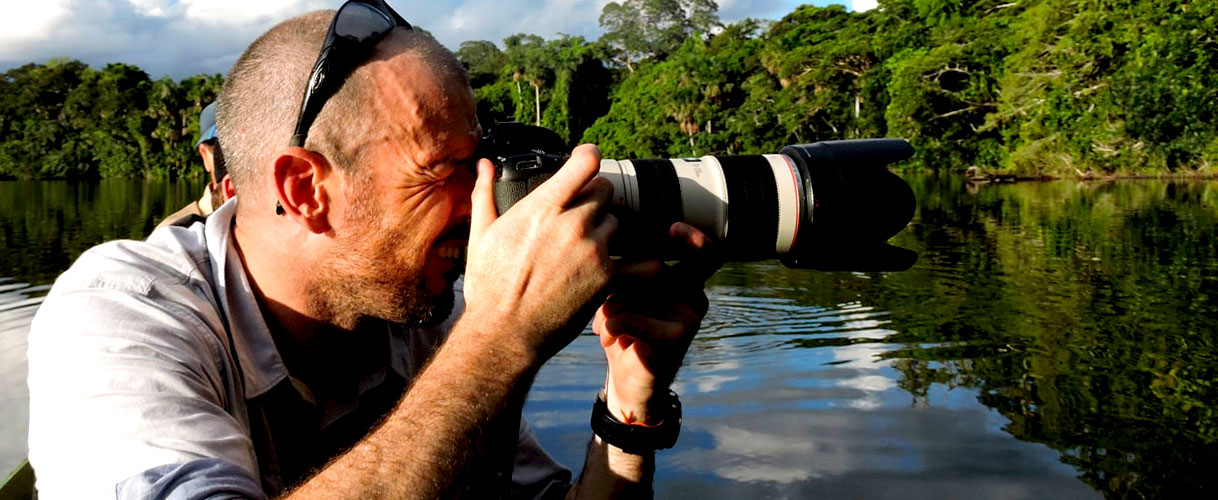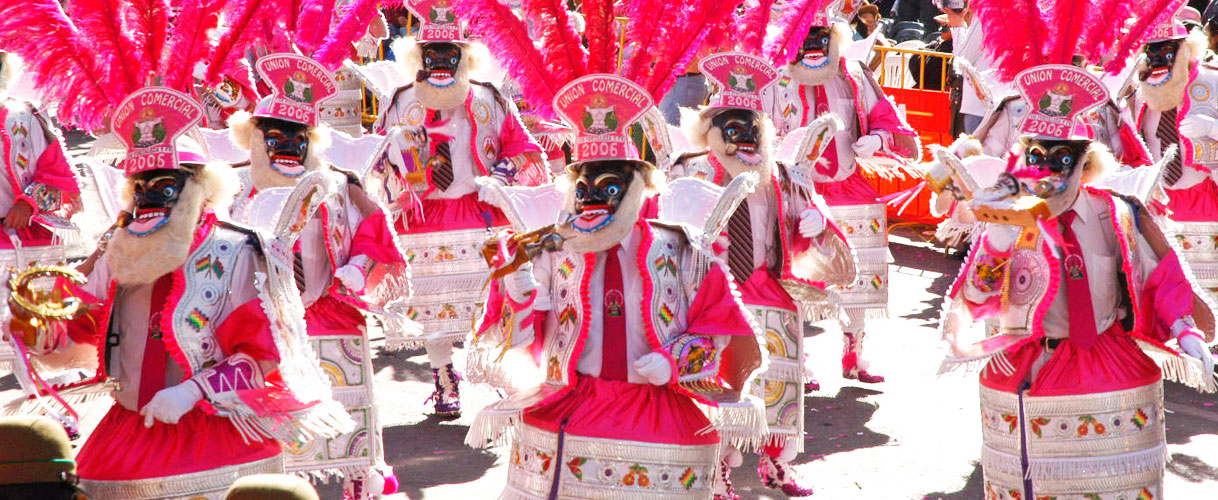Bolivia Travel Guide
The best places to visit
UYUNI SALT FLATS AND THE EDUARDO AVAROA RESERVE
Uyuni is a place whose history tells the greatness of the railway age in Bolivia, when the Central Station was connection shaft with the South, after the Pacific War that left Bolivia without a sovereign outlet to the sea. It is the gateway to the Salar that bears his name, the one that for indigenous people has the name of Thunupa, an immense White Sea salt that it is considered an inexhaustible resource center for Bolivia.
Surrounding the Salar de Uyuni, the communities implemented eco-lodges with the aim of offering tourists a unique experience in visiting the area. Uyuni is also the portal of entry into the National Reserve Eduardo Abaroa for Andean Fauna, where are located the colored lagoons: Laguna Verde and Laguna Colorada, two places whose landscapes are reminiscent of the paintings of the Catalan painter Salvador Dali.
The Uyuni Salt Flats and the Sud Lípez region are the most visited and admired destinations of Bolivia, thanks to their extraordinary landscapes, which are unique in the world.
Being the largest reservoir of salt and lithium of the world, Uyuni Saltflat is an inmense extension of rustic beauty and holds infinite horizons. A true “internal sea”, with smarine fossil traces, calcareous formations and giant cactuses, where the most overwhelming solitude and silence can be experienced. White impeccable during the dry season and the perfect sky mirror during the rainy season, the Saltflat saves for its visitor’s levitation and mirage phenomena that disrupt your senses, making the tour a quite personal and always different experience.
As a tour extension to the Salar de Uyuni, the Eduardo Abaroa Reserve in Sud Lípez, has treasures of natural and geological richness. There it takes place a combination of strange rock formations, deep pools of thermal waters, geisers and the famous colored lagoons: the last one located at the bottom of the imponent Licancabur volcano.
The Eduardo Avaroa Reserva complies basic shelters and rustic hotels offering the vistor a high comfort stay, they’re located in marvelous natural environs between Uyuni Saltflat and the Bolivia-Chile border (Hito Cajón). Supernatural landscapes, colored lagoons, geisers, thermal waters, and typical fauna of the region constitute a quite unique tour.
Location: Department of Potosí, D. Campos, A Quijarro Sud and Nor Lípez
Nearest capital city: Potosí, 215 kms.
Altitude: 3653 to 4892 m.s.l
Temperature: 12 ° C annual average

AMAZONIA, natural and cultural richness
Covering almost two thirds of the national territory, the Bolivian Amazon river basin is a vast repository of natural biodiversity, with flora and fauna in wild state. All in protected areas such as the Madidi National Park, the Manuripi-Heat National Reservoir of Amazon Fauna, in the Department of Pando. Ran through by huge extraordinary rivers like Beni, Madre de Dios and Mamore, it is comprised by forests, lagoons, savanna and cities like Rurrenabaque, Trinidad, Riberalta, Guayaramerín and Cobija, which were built on the economic importance of rubber as well as chestnut production and commence.
Bolivian Amazon guards important archeological richness, especially from “Mojeña” culture, such places as Chuchini, near Trinidad, whose gigantic hills with hydraulic constructions still generate questionings among the studious. Many of the original cultures in this region continue to preserve ancient traditions and ways of life, in harmonious relation with nature.
The Bolivian Amazon has a relevant historic inheritance, with missionary populations like San Ignacio de Moxos, and communities such as Loma Suárez and Cachuela Esperanza, whose republican cultural and architectural heritage, portraits the economic splendour of north east Bolivia during the topmost height of rubber exploitation by the end of the nineteenth century. Also the Tacana etnic group at the north of La Paz.
North of La Paz
Location: Department of La Paz, Abel Iturralde, Franz Tamayo
Altitude: 1025 m.a.s.l
Temperature: 21° C, annual average
Trinidad
Location: Department of Beni, Cercado
Altitude: 155 m.a.s.l
Temperature: 26,1° C, annual average
Cobija
Location: Department of Pando, Provincia Cercado
Altitude: 235 m.a.s.l
Temperature: 28° C, annual average

SAJAMA NATIONAL PARK
If there is a place where the history of planet Earth is taught by the very nature in itself this is the Sajama National Park, located in the northwest of the department of Oruro, 255km from the city of La Paz.
In this park you can find hot springs, wetlands with their eternal moisture, trees growing from decade to decade (quñua), mosses that are more fuel than the oil in itself (yareta), kollpares, geysers, volcanoes, eternal snows, and wisdom of a people who lived for centuries in this place. Among all this magnificence is the snowy Sajama, the father of the whole area, the “doctor”, as they call traditional doctors, the supervisory body of the park, patron saint of Bolivia. His millennial companions: Pomereque and Parinacota are his two personal guards.
It is Choquemarca Suni Uta community that has initiated a community undertaking in that area with a shelter that has been called Tomarapi, after the small hill on which it is located. Also in an area a little more far, the Tahipiuta community has implemented an eco-lodge, the Kory Trincha. Each of them has become a gateway for tourists, with services that inherently carry the principles of the Andean complementarity.

LA PAZ CITY
Emplaced in a fertile valley in the middle of the andean plateau, La Paz is as unique a city as the contrasts of its peculiar geography. Political, cultural and artistic Capital of Bolivia, in its steep and tight streets are combined different features of our indigenous, colonial, republican and contemporary altogether identity. A city that is so intense, with multiple options for cultural tourism, commerce, entertainment and amusement.
Location: Department of La Paz, Murillo
Altitude: 3650 m.s.l
Temperature: 11°C annual average

TITICACA, the sacred lake
Surrounded by beautiful snowcapped mountains, Lake Titicaca is the highest navigable area in the world, and home to ancient agricultural and fishing communities of aymara origin. It is an essential source of Bolivian culture and point of encounter to religion, tradition and beliefs. Besides the landscape full of energy and mysticism, Titicaca has various attractions, of great interest due to their archaeological and cultural relevance.
Copacabana peninsula, ceremonial center since pre-Hispanic cultures, where the Sanctuary of the Virgen de Candelaria (Virgin of the Candlelight) is located, a pilgrimage point among the most important in the country. Suriki, an island home to renowned totora reed boat builders. Pariti island, with a museum of recently discovered clay works of Tiwanaku origin.
The lovely island of the Sun and Island of the Moon, where various meaningful Inca monuments are preserved, such the case of Pilcocaina Palace, Chinkana, the sacred sanctuary of Titi Kala or Rock of the Cougar, and the Iñak Uyu Palace or Temple of the Moon.
Sampaya
Sampaya is a community located near the banks of Lake Titicaca, in the Municipality of Copacabana, where it has been possible to organize a thematic circuit that revalues all millenarian urban and architectural structure, cultural attractions and the beauty of its natural environs. It offers lodging service and typical handicrafts, besides the visits to crop terraces, and irrigation and drainage systems, all of Inca origins.
Location: Department of La Paz, Manco Kapac
Nearest capital city: La Paz, 147 kms.
Altitude: 3841 m.a.s.l
Temperature: 11°C, annual average

LOS YUNGAS
The zone of Yungas in Bolivia is an Eco Region of thick forests and exuberant flora, with a fauna living in harmony with Mother Earth. It is a place located in the Department of La Paz, where rivers, roads forests and mountains have become a favorite destination for Adventure Tourism.
In La Paz area it is divided into two provinces: Nor Yungas and Sud Yungas, in the first province are located villages such as Coroico, Coripata and Yolosa, while in Sud Yungas the most known tourist destinations are Chulumani and Yanacachi.
Very important tourist activities are carried out in these tropical areas of La Paz, on first place is the Death Road, a dangerous downhill path which edge is surrounded by kilometers of ravine. On the other hand sports like paragliding cycling long-winded, mountain climbing and hiking are practiced by tourists coming from distant countries, in the interest of knowing an area which is still maintaining its biodiversity and ecology.
In Los Yungas there is the ethnic group of the Afro-bolivian community called Tocaña, who are direct descendants of the first men of color brought by the Spaniards from Africa to work in the colonial mines.
Yolosa village is regarded as the gateway to Coroico. In its environs it is located the Laguna Cedro Mayo, natural spa that offers a resting place for tourists and visitors. In addition to enable them to enjoy attractions such as the Recovery Center Wildlife Senda Verde. Yolosa is an important village to learn more about the growings of the high altitude coffee production and coca leaf.

TIWANAKU
This magnificent cultural, political and religious center is one of the splendorous trace of a representative culture in South America, whose influence extended to the subtropical valleys of our country, the Peruvian mountains, the Atacama Desert and northern Argentina.
Tiwanaku is the most important archaeological heritage in our territory, by the refinement of its architecture and stone sculptures, expressed in unique monuments such as la Puerta del Sol (The Gate of the Sun), the Templete Semi subterráneo (Semi-subterranean Temple), the Pirámide de Akapana (Pyramid of Akapana) or the amazing Kalasaya.
The archeology complex reflects a poignant quest for perfection in the realm of science and arts, which still today, exerts a continuing influence on religious thought, culture aesthetics and cosmovision of our Andean communities.
With rather more questions than answers, the origin and expansion of Tiwanaku is a fascinating mystery that still captivates researchers and visitors from around the world.
Location: Department of La Paz, Ingavi
Nearest capital city: La Paz, 72 kms.
Altitude: 3842 m.a.s.l
Temperature: 10°C, annual average

SUCRE, "The White City"
Sucre is one of the most beautiful colonial cities of America. It was seat of the Audiencia de Charcas in colonial times, cradle of the first libertary movements and Capital District of Bolivia since its independance, it preserves a magnifiscent colonial and neoclasic republican heritage, which reflects its importance as a political, social, artistic, academic and cultural center. The surroundings have also natural, paleontological and cultural attractions of great interest for the visitor. Sucre is a UNESCO World Heritage Site.
Communitary touristic centers of Maragua and Potolo
The Jalq’a communities of the Departament of Chuquisaca are well known for their beautiful weavings, processed with natural dyes and ancient techniques. This project intends to value and preserve natural and cultural resources in the region, through the construction of the Communitary Museum of the Jalq’a Culture Agro. This offer is complemented with five lodges, and artisan center and the Museum of traditional Medicine.
Cretaceous Park
Located in the area of Cal Orko, a few minutes away from the city of Sucre, it has an important paleontologic heritage, since there are to be found the most extensive dinosaur traces in the world. This is a thematic park, with extensive natural areas in which full scale replica of dinosaur species have been placed accordingly to the traces found. There is also a thematic museum, restaurant services and souvenir store.
Location: Department of Chuquisaca
Nearest capital city: Potosí, 463 kms.
Altitude: 1870 m.s.l
Temperature: 15,5 ° C annual average

POTOSI, heritage of the world
The history of Potosí, is related to the mythical "Cerro Rico" (Rich Mountain) and its extraordinary mineral richness. During the mid-17th Century, Villa Imperial (Imperial Vila) was synonym of the highest wealth and splendor, at such point as to became one of the most important cities in the world. Along with La Paz, it is cradle to the so called "Barroque Mestizo", a powerful artistic and architectural expression, product of the cultural syncretism between the religious ideas of the Spanish conqueror and the cosmovision of the indigenous people. Potosí is a UNESCO World Heritage Site.
Museum & Coffe Shop Planta Diesel Miraflores, Uncía
Located in the proximities of the famous Mine “La Salvadora” which belonged to the “Tin Baron” Simon Patiño. The Project is about restoring and functionalizing the old power plant, which holds two smaller plants similar to the ones used in the Titanic and built by the same factory, five years before the famous ship collapsed. There is a cozy Museum-Coffee Shop where the visitor can learn about Bolivian mining history.
Diego Huallpa Mining Museum of the Cerro Rico (Rich Mountain)
With singular and novel characteristics, this museum is located in the adits of the mythical Cerro Rico, in the city of Potosi. It offers a tour through different thematic halls, worked to the inside of the mountain, which allow the visitor to learn about the history of mining on silver and tin, inside the largest argentiferous reservoir, exploited during the Colony.
Location: Department of Potosí
Altitude: 4070 m.s.l
Temperature: 8,9 ° C, annual average

THE ORURO CARNIVAL, master piece of culture and folklore
An extraordinary expression of the religious and cultural syncretism in Bolivia, the Oruro Carnival is the largest folklore event in our country. The climax of this great celebration is reached on Carnival Saturday, as thousands of dancers gathered in fraternities, carry out the famous “Entrance”, a three kilometer journey throughout the city’s streets to the Sanctuary of the "Virgen del Socavón".
Spectacular dances such as Diablada, Morenada, Caporales and Tinku, with extraordinary plasticity and color, portrait ancient myths, traditions and histories of the Andean people. The Oruro Carnival is also a proud display of the mastery of local artisan embroiderers and mask makers, who work almost the whole year to design and manufacture the participants’ suits.
The Oruro Carnival has been designated UNESCO Oral and Intangible Heritage of Humanity.
The department of Oruro has, as well, important attractions of cultural, archaeological and natural characteristics, such as the Sajama National Park, among the most visited in Bolivia.
Museum of Sacred Art
Craftsmen, mask makers, embroiderers and local artists, carried out the restoration of the museum ambients and of the religious paintings, which hold a great cultural value.
Location: Departamento de Oruro, Provincia Cercado
Altitude: 3706 m.a.s.l.
Temperature: 10,7 ° C, annual average

